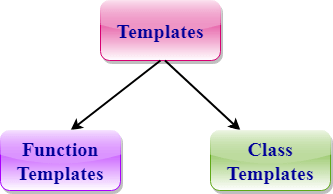C++ TemplatesA C++ template is a powerful feature added to C++. It allows you to define the generic classes and generic functions and thus provides support for generic programming. Generic programming is a technique where generic types are used as parameters in algorithms so that they can work for a variety of data types. Templates can be represented in two ways:

Function Templates: We can define a template for a function. For example, if we have an add() function, we can create versions of the add function for adding the int, float or double type values. Class Template: We can define a template for a class. For example, a class template can be created for the array class that can accept the array of various types such as int array, float array or double array. Function Template
Syntax of Function TemplateWhere Ttype: It is a placeholder name for a data type used by the function. It is used within the function definition. It is only a placeholder that the compiler will automatically replace this placeholder with the actual data type. class: A class keyword is used to specify a generic type in a template declaration. Let's see a simple example of a function template: Output: Addition of i and j is :5 Addition of m and n is :3.5 In the above example, we create the function template which can perform the addition operation on any type either it can be integer, float or double. Function Templates with Multiple ParametersWe can use more than one generic type in the template function by using the comma to separate the list. SyntaxIn the above syntax, we have seen that the template function can accept any number of arguments of a different type. Let's see a simple example: Output: Value of a is : 15 Value of b is : 12.3 In the above example, we use two generic types in the template function, i.e., X and Y. Overloading a Function TemplateWe can overload the generic function means that the overloaded template functions can differ in the parameter list. Let's understand this through a simple example: Output: Value of a is : 10 Value of b is : 20 Value of c is : 30.5 In the above example, template of fun() function is overloaded. Restrictions of Generic FunctionsGeneric functions perform the same operation for all the versions of a function except the data type differs. Let's see a simple example of an overloaded function which cannot be replaced by the generic function as both the functions have different functionalities. Let's understand this through a simple example: Output: value of a is : 4.6 Number is even In the above example, we overload the ordinary functions. We cannot overload the generic functions as both the functions have different functionalities. First one is displaying the value and the second one determines whether the number is even or not. CLASS TEMPLATEClass Template can also be defined similarly to the Function Template. When a class uses the concept of Template, then the class is known as generic class. SyntaxTtype is a placeholder name which will be determined when the class is instantiated. We can define more than one generic data type using a comma-separated list. The Ttype can be used inside the class body. Now, we create an instance of a class where class_name: It is the name of the class. type: It is the type of the data that the class is operating on. ob: It is the name of the object. Let's see a simple example: Output: Addition of num1 and num2 : 11 In the above example, we create a template for class A. Inside the main() method, we create the instance of class A named as, 'd'. CLASS TEMPLATE WITH MULTIPLE PARAMETERSWe can use more than one generic data type in a class template, and each generic data type is separated by the comma. SyntaxLet's see a simple example when class template contains two generic data types. Output: Values of a and b are : 5,6.5 Nontype Template ArgumentsThe template can contain multiple arguments, and we can also use the non-type arguments In addition to the type T argument, we can also use other types of arguments such as strings, function names, constant expression and built-in types. Let' s see the following example: In the above case, the nontype template argument is size and therefore, template supplies the size of the array as an argument. Arguments are specified when the objects of a class are created: Let's see a simple example of nontype template arguments. Output: 1 2 3 4 5 6 7 8 9 10 In the above example, the class template is created which contains the nontype template argument, i.e., size. It is specified when the object of class 'A' is created. Points to Remember
Next TopicC++ Tutorial
|
 For Videos Join Our Youtube Channel: Join Now
For Videos Join Our Youtube Channel: Join Now
Feedback
- Send your Feedback to [email protected]
Help Others, Please Share










